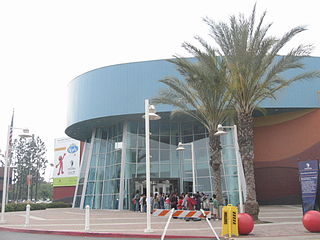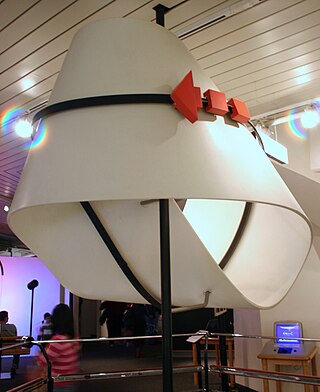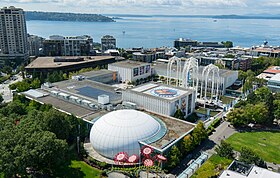
Minoru Yamasaki was a Japanese-American architect, best known for designing the original World Trade Center in New York City and several other large-scale projects. Yamasaki was one of the most prominent architects of the 20th century. He and fellow architect Edward Durell Stone are generally considered to be the two master practitioners of "New Formalism".

The Century 21 Exposition was a world's fair held April 21, 1962, to October 21, 1962, in Seattle, Washington, United States. Nearly 10 million people attended the fair during its six-month run.

The 1964–1965 New York World's Fair was a world's fair that held over 140 pavilions and 110 restaurants representing 80 nations, 24 U.S. states, and over 45 corporations with the goal and the final result of building exhibits or attractions at Flushing Meadows–Corona Park in Queens, New York City. The immense fair covered 646 acres (2.61 km2) on half the park, with numerous pools or fountains, and an amusement park with rides near the lake. However, the fair did not receive official support or approval from the Bureau of International Expositions (BIE).

IMAX is a proprietary system of high-resolution cameras, film formats, film projectors, and theaters known for having very large screens with a tall aspect ratio and steep stadium seating, with the 1.43:1 ratio format being available only in few selected locations.

The Alaska–Yukon–Pacific Exposition, acronym AYP or AYPE, was a world's fair held in Seattle in 1909 publicizing the development of the Pacific Northwest. It was originally planned for 1907 to mark the 10th anniversary of the Klondike Gold Rush, but the organizers learned of the Jamestown Exposition being held that same year and rescheduled.
The Oregon Museum of Science and Industry is a science and technology museum in Portland, Oregon, United States. It contains three auditoriums, including a large-screen theatre, planetarium, and exhibition halls with a variety of hands-on permanent exhibits focused on natural sciences, industry, and technology. Transient exhibits span a wider range of disciplines.

Seattle Center is an entertainment, education, tourism and performing arts center located in the Lower Queen Anne neighborhood of Seattle, Washington, United States. Constructed for the 1962 World's Fair, Seattle Center's landmark feature is the 605 ft (184 m) Space Needle, an official city landmark and globally recognized symbol of Seattle's skyline. Other notable attractions include the Pacific Science Center, Climate Pledge Arena, and Museum of Pop Culture (MoPOP), as well as McCaw Hall, which hosts both the Seattle Opera and Pacific Northwest Ballet. The Seattle Center Monorail provides regular public transit service between Seattle Center and Westlake Center in Downtown Seattle, and is itself considered a tourist attraction.

Fernbank Museum of Natural History, in Atlanta, Georgia, is a museum that presents exhibitions and programming about natural history. Fernbank Museum has a number of permanent exhibitions and regularly hosts temporary exhibitions in its expansive facility, designed by Graham Gund Architects. Giants of the Mesozoic, on display in the atrium of Fernbank Museum, features a 123-foot (37 m) long Argentinosaurus, the largest dinosaur ever classified; as well as a Giganotosaurus. The permanent exhibition, A Walk Through Time in Georgia, tells the twofold story of Georgia's natural history and the development of the planet. Fernbank Museum has won several national and international awards for one of its newest permanent exhibitions, Fernbank NatureQuest, an immersive, interactive exhibition for children that was designed and produced by Thinkwell Group. The awards NatureQuest has won include the 2012 Thea Award for Outstanding Achievement for a Museum Exhibit and the 2011 Bronze Award for Best Museum Environment from Event Design. The nearby Fernbank Science Center is a separate organization operated by the DeKalb County Board of Education and is not affiliated with Fernbank Museum of Natural History.

The Museum of Science (MoS) is a nature and science museum and indoor zoological establishment located in Science Park, a plot of land in Boston and Cambridge, Massachusetts, spanning the Charles River. Along with over 700 interactive exhibits, the museum features a number of live and interactive presentations throughout the building each day, along with scheduled film showings at the Charles Hayden Planetarium and the Mugar Omni Theater. Additionally, the Museum of Science is an accredited member of the Association of Zoos and Aquariums (AZA), being home to over 100 animals—many of which have been surrendered, confiscated, rescued or rehabilitated.

The Science Museum of Minnesota is an American museum focused on topics in technology, natural history, physical science, and mathematics education. Founded in 1907 and located in Saint Paul, Minnesota, the 501(c)(3) nonprofit institution has 385 employees and is supported by volunteers.

The Saint Louis Science Center, founded as a planetarium in 1963, is a collection of buildings including a science museum and planetarium in St. Louis, Missouri, on the southeastern corner of Forest Park. With over 750 exhibits in a complex of over 300,000 square feet (28,000 m2), it is among the largest of its type in the United States.

Expo '74, officially known as the International Exposition on the Environment, Spokane 1974, was a world's fair held May 4, 1974, to November 3, 1974 in Spokane, Washington in the northwest United States. It was the first environmentally themed world's fair and attended by roughly 5.6 million people. The heart of the fair park grounds was located on Canada Island, Havermale Island, and the adjacent south bank of the Spokane River, comprising present-day Riverfront Park, in the center of the city.

The California Science Center is a state agency and museum located in Exposition Park, Los Angeles, next to the Natural History Museum of Los Angeles County and the University of Southern California. Billed as the West Coast's largest hands-on science center, the California Science Center is a public-private partnership between the State of California and the California Science Center Foundation. The California Natural Resources Agency oversees the California Science Center and the California African American Museum. Founded in 1951 as the "California Museum of Science and Industry", the Museum was remodeled and renamed in 1998 as the "California Science Center". The California Science Center hosts the California State Science Fair annually.

Telus World of Science Edmonton (TWOSE) is a broad-based science centre in Edmonton, Alberta, Canada, operated by the (non-profit) Edmonton Space & Science Foundation. The centre is located on the southwest corner of Coronation Park in the neighborhood of Woodcroft. The science centre houses 144,430 sq. ft. of public space and is the largest science centre in Western Canada. It is currently a member of both the Association of Science-Technology Centers (ASTC) and the Canadian Association of Science Centres (CASC).

Rainier Tower is a 41-story, 156.67 m (514.0 ft) skyscraper in the Metropolitan Tract of Seattle, Washington, at 1301 Fifth Avenue. It was designed by Minoru Yamasaki, who designed the World Trade Center in New York City as well as the IBM Building, which is on the corner across the street from Rainier Tower to the southeast. Its construction was completed in 1977.

The Houston Museum of Natural Science is a natural history museum located on the northern border of Hermann Park in Houston, Texas, United States. The museum was established in 1909 by the Houston Museum and Scientific Society, an organization whose goals were to provide a free institution for the people of Houston focusing on education and science. The museum complex consists of a central facility with four floors of natural science halls and exhibits, the Burke Baker Planetarium, the Cockrell Butterfly Center, and the Wortham Giant Screen Theatre. In 2022, the museum received 1,520,000 visitors, making it seventh on the List of most-visited museums in the United States, and was the third most-visited U.S. science museum. Much of the museum's popularity is attributed to its large number of special or guest exhibits.

Raisbeck Aviation High School (or RAHS), part of the Highline School District, is located in Tukwila, Washington. The school is an aviation- and aerospace-themed STEM school and one of the Highline School District's small schools. It is focused on preparing students for college, careers, and citizenship. The school serves about 400 students in grades 9-12 from around Puget Sound. Until 2013 it was known as Aviation High School. It is next to the Museum of Flight's Aviation Pavilion exhibit near King County International Airport.

The Discovery Cube Orange County, formerly known as the Discovery Science Center and the Taco Bell Discovery Science Center, is a science museum in Santa Ana, California, with more than 100 hands-on science exhibits designed to spark children's natural curiosity. Designed by the architect firm Arquitectonica with structural engineers Carl Johnson and Svend Nielsen, it has become a visual landmark due to its ten-story solar array cube that stands over Interstate 5.

Mathematica: A World of Numbers... and Beyond is a kinetic and static exhibition of mathematical concepts designed by Charles and Ray Eames, originally debuted at the California Museum of Science and Industry in 1961. Duplicates have since been made, and they have been moved to other institutions.






















